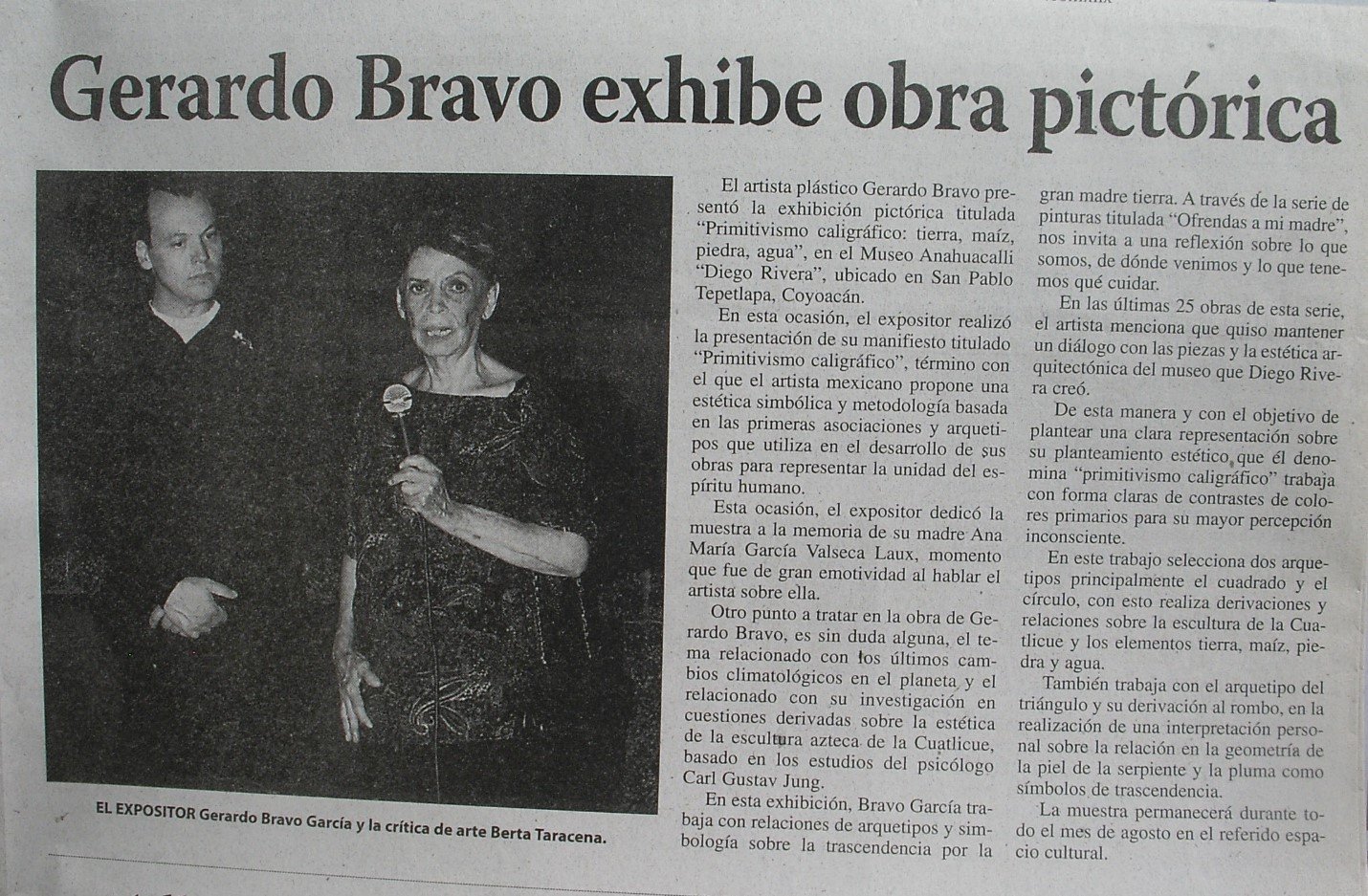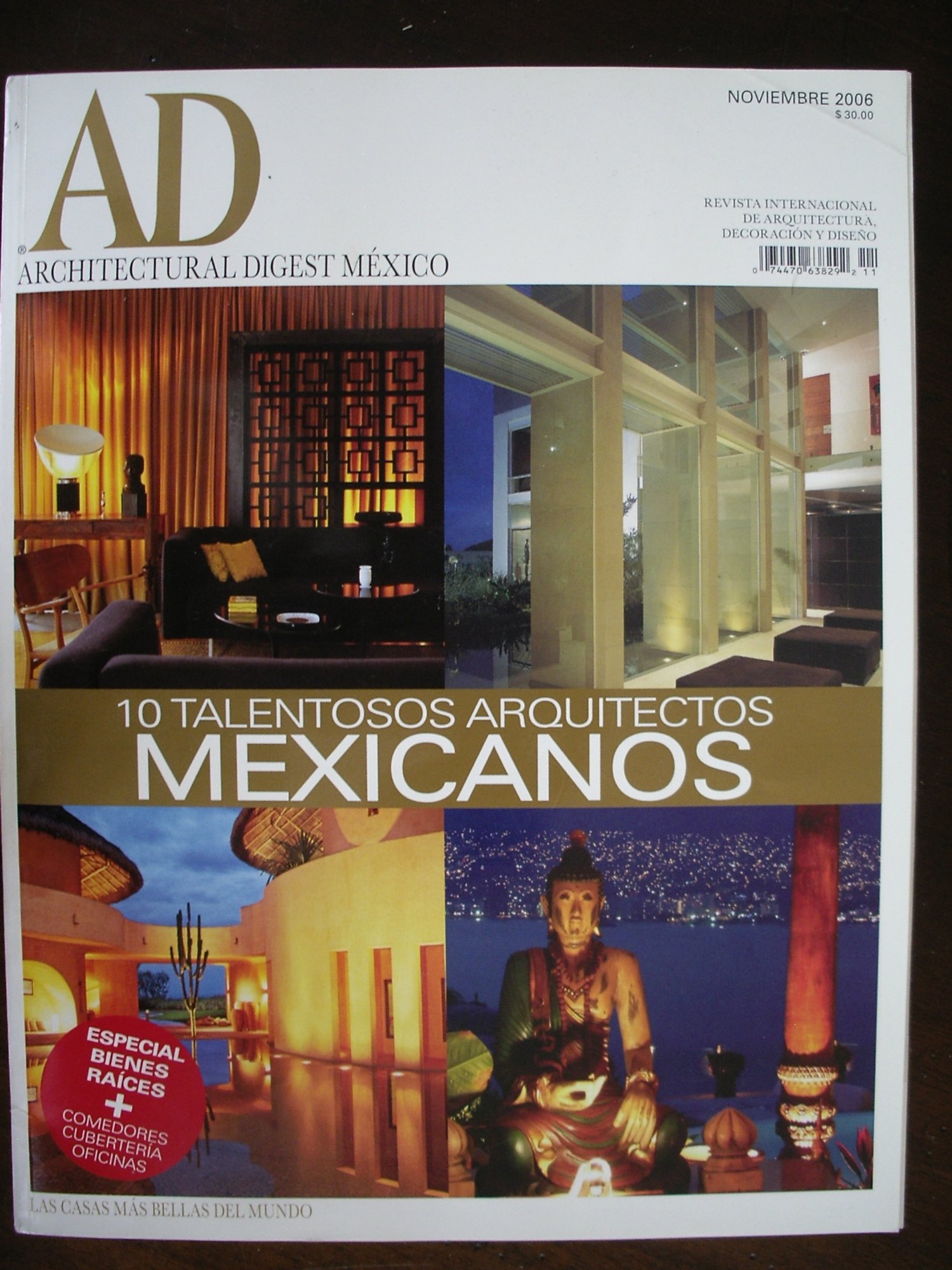Espinosa Ricardo, "Gerardo Bravo exhibits pictorial work" El Sol de México newspaper, society section, August 5, 2007. p. 4D
New world view in the art of Gerardo Bravo Garcia.
By Berta Taracena
Without question, Gerardo Bravo has undergone a surprising evolution both in terms of form and content as well as in terms of his painting technique. Such change has resulted from the artist’s ability to successfully establish defining, reciprocal patterns in the codes of his visual expression.
While there was some pictorial objectivism in the early stages of his works (1996-2005), today in his most recent series (2007) the object has become ‘objectified” with the greatest propriety, as the shedding of the early clothes have brought about real stylistic Changes in the poetic language of this artist.
This new form of expression, which begins with series such as Offerings to my mother and Calligraphic Privateness, is at this stage a very elaborate focal image that is almost structurally cast in stone with multiple relief figures, forms and lines that generate the optical illusion of corporeality set on a real but magical surrounding space with their own distinct connotations.
Obviously, any research into Gerardo Bravo Garcia’s works cannot be merely confined to the immediate expressive aspect, for its current level of excellence results from that material continuum that identifies him, which may well escape a first reading, as it consists of the so-called micro structures that the artist is so passionate about. We are dealing in this case with both fortuitous elements and lumps of matter, cloth or wood textures, the glitter of golden leaves, the ribs of various materials used and other abstract and figurative variations as well as the essential components that shape his work’s complete primer, namely the study of light, viewing angles, the power of color and specially the interpretive analysis of his work’s aesthetic universe, which will vary according to the eye of the beholder.
With respect to forms in Bravo’s works, they typically behave in ambiguous and thoughtful way, in line with the author’s wishes to create high levels of improbability and questioning, thus building a strong sense of information into the message, as he challenges and provokes the viewer’s gifts for interpreting forms, colors and symbols.
In terms of both the abstract and the iconic or figurative schools of painting, including other emerging trends observed, mention must be made of the use of what may be called a backdrop against which figures or even content leitmotifs are displayed. The backdrop has been a very important feature in recent works as it shows the sharp change that has occurred in the size and scale of his paintings, which have gone from miniature to mural-sized paintings. This backdrop or background contains references to the axial leitmotif, which is countered by a very strong sense of realism or magic on works such as Stone-water, Stone-corn, Earth-water, Eart-corn and other works within the series on Offerings to AMGVL, which open up new areas in Gerardo Bravo’s visual language due to its monumental scale and multiple meanings.
The artist’s visual language is formed by an intertwined web of associations, archetypes, symbols, derivatives, and various events, which becomes more impressive the more unlikely and absurd it gets. The concurrent perception of specific broken spaces in his works will create a sharp tension on his viewing audience. This tension will become more intense as the artist departs from conventional rules, which tend by their signifiers, which makes it extremely arduous for the viewers to read each painting and they do not know how far they may go in their investigative inquiry.
For instance, when the painter adds the acronyms “AMGVL” which stands for his mother’s name initials, to each title of his Offerings series, he is alluding to the fact that his work is dedicated to the memory of his mother, Ana Maria Garcia Valseca Laux, who inspired him to study arts from his early childhood. Once found or perceived by his viewing audience, this is a piece of information that will bring them not only a sense of discovery but also a feeling of aesthetic enrichment.
Such effect is constant pattern that repeats itself all along Gerardo Bravo’s work series trajectory from the Psalms to Mandalas to Offerings, as a style of calligraphic privateness, which leaves his viewing audience at liberty to choose from multiple and various meanings being present to them, as they are no longer compelled by either form or content to stick to one absolute choice.
The viewer therefore becomes a sort of co-author per se of the work, thereby transforming it from univocal or closed into a polyvalent or open work.
Thus, the stylistic change in the work of this refined artist actually involves a change of world view, wherein you may find the idiolect of all possible visual and poetic encodings.
Berta Taracena, Mexico City 2007
2003-2006 Design and construction country family house in Mexico City.
Rolando Diez Laurini, "Medieval Influence", 10 talented Mexican architects, Architectural Digest Mexico magazine, volume 7, November 2006, p. 74-79.
Visual artist Gerardo Bravo, a graduate from the National School of Visual Arts of the San Carlos Academy, is a self-taught architect who has worked on numerous renovation projects in Mexico City, He has in charge of the design and oversight of Futon Tanoshii Stores. His pictorial work has been displayed on various national and international exhibitions and it is part of both public and private collections.
He designed and built this beautiful house, in which he combines the harmony of classic architecture with the stylization of modern art.
Based on the concept of troje (Indigenous Michoacan granary architecture), which is now a part of the main room, he decided to build on the luxuriant natural environment with the idea of preserving the ancient model of indigenous granaries and combine the usage of woodwork and quarry stones in order to re-create an ancient and mystic type work with roomy, inviting spaces for meditation.
Built on Los Remedios quarry stone, which is a smooth light-colored stone, and using the original texture on aged wood, Bravo Garcia manages to strike a balance to create the desired feel. As he strives to give it a smooth finish look, he avoids making any sharp cuts or edges on materials by polishing or rounding off corners or edges on walls, ceilings doors and windows so as to eliminate the appearance of rigidity.
Built against the breath-taking background of Lion’s Dessert National Park, the house draws on a variety of scenic views of both mountain and city landscapes located at 8,400 ft above sea level, and includes the concept of landscaped terraces on the first story to provide the bedrooms with the feel of ground floor.
The three large floor-to ceiling windows overlooking the gardens were designed for the propose of providing a countryside view to the property. Interiors provide a warm and austere ambience that imparts elegance and sobriety to the building interior, as it avoids the use of unnecessary frills or details, wile using the granaries original carved friezes, doors and fixtures. The building interiors were designed to showcase its roomy space as the ornamental centerpiece and source of sumptuous peace and serenity.
The spherical vault over the sitting-dining room was inspired on a former convent located in the forest. Besides its majestic presence, it acts as a sound box that amplifies the interior acoustics, thereby enabling guest to speak without having to raise their voices. Hand-carved in the best medieval style, arch stone by arch stone, this is a squares and circles design intended to honor the concept of the squaring of the circle, which was the subject of so much concern to alchemist. This area is an example of functional ancient architecture at its best. In this regard, Gerardo Bravo has indicated, “The circular vault is like a return to the mother’s womb; it provides a feeling of protection and comfort, which is created by the circular space.”
The house décor has been defined by the earth and natural colors of the materials used. The exterior painting for the masonry was prepared on the basis of old lime paint recipes, which combine the use of local clays and red soils from Queretaro. The goal in using this décor was to recreate the understated elegance of a monastery.
The brightness of the sunlight plays a critical role in creating an atmosphere through enhanced architectural lines, as windows are oriented in such a way that they will get flooded with sunlight during the day, this color on the wooden floors creates an amber reflection that enhances the room’s warm feel. Consideration was given to the use of a light and neutral color for walls and masonry soffits, and a natural wood interior finish to ensure a fuller use of day light, For artificial lighting, mostly indirect warm incandescent dichroic lamps with dimmer switches embedded in wall, soffit and cornice receptacles were used in order to provide a pleasant light on materials that will enhance the architecture and preserve the privacy of spaces.




